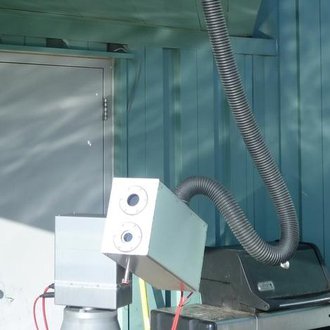SDI für PEPSI
The main purpose of the Solar Disk Integrated (SDI) telescopes is to feed disk-unresolved solar light - aka the Sun as a star - to the currently most powerful stellar spectograph in the world - PEPSI. Its successor, SDI-POL allows to do this for polarimetric light. Besides providing an independent means of monitoring the spectrograph's point-spread function over time, it will also provide an unprecedented set of quasi-continuous, long-term, high-resolution, time-resolved spectra of the solar disk. For the Sun, this allows us to study the dynamics of the solar atmosphere over an entire solar cycle. Profile variations of photospheric lines can be used, if carefully chosen, to study overall variations of temperature and pressure. Chromospheric lines as sensitive indicators of the net UV and X-ray flux may be used to study variations of the magnetic activity of the Sun. But the example of the Sun might be exploited in further ways: We will be able to test and study differential rotation of the Sun with the same techniques we apply to stars and, using the polarimetric mode, we will be able to verify our multipole magnetic field models of the Sun-like stars and to compare them to the net solar magnetic field variations available through SDI measurements.
The data flow is determined from the goal to obtain three full-wavelength R=300,000 spectra with S/N of approx. 5,000:1 per day. One full PEPSI spectrum is comprised of three cross-disperser (CD) settings (a total of six exposures because PEPSI has two arms). This covers the wavelength range of 383 to 907 nm. We expect to reach a peak S/N ≈ 500:1 in a single 2-sec exposure and thus need roughly 100 consecutive spectra per CD setting. With an expected read-out time of 12 sec plus a 1 sec safety overhead, the cadence per CD setting is 1500 sec (25 min). Changing from one CD to the other is expected to take ≈ 1 min. A single Th-Ar wavelength calibration frame is expected to take also ≈1 min. The total time on a target (i.e. the Sun) is then 78 min. This sequence is then repeated twice to give three independent spectra. The total time needed is approximately 240 min (4 hours).
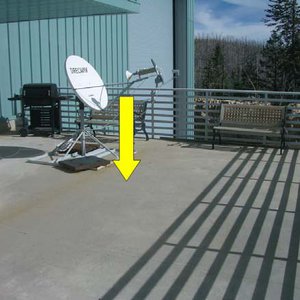
Balcony of LBT, before SDI installment
Credit: AIP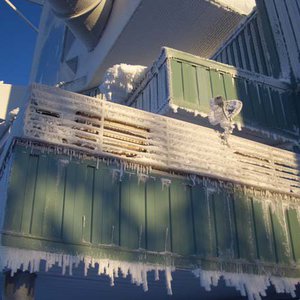
Ice - great danger to SDI.
Credit: AIP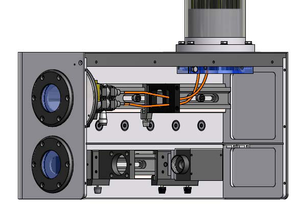
Drawing of the SDI design.
Credit: AIPThe SDI telescope is located on the open terrace of the 2 x 8.4 m Large Binocular Telescope (LBT). As a true robotic telescope, it automatically starts up as the Sun rises, acquires the Sun as early as possibly and continuously tracks its position, unless meteorological conditions do not allow a safe operation of the telescope (main operation problem at LBT site is icing). Clouds permitting, an additional guider telescope locks on the Sun and keeps the pointing accurately aligned. The two 10 mm telescopes image the solar disk into 300 μm fibers, which are connected on their other end to the two PFUs located on the Nasmyth focus platforms of the LBT. The 100 μm target fiber will be used to achieve a resolving power of R=320 000. A passively stabilized and sealed Fabry-Perot etalon will be used for the simultaneous wavelength calibration of the solar spectrum via the sky background fibers of the PFUs. The internal accuracy of the calibration should reach up to 3 cm/s.
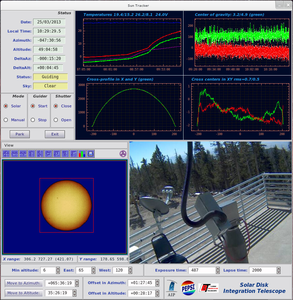
GUI for controlling the SDI
Credit: AIPThe SDI itself is based on the Sun Tracker SPTRV5 from Dr. Schulz+Partner GmbH, which is delivered with an alt-az mount. Two stepper motors (resolution 32″) in an environmentally protected box are up-linked to a PC through an RS232 serial interface. They are seamlessly integrated in the SDI-control GUI visible in the image. The sky status (clear/cloudy) is determined from the smoothness of the x/y profiled visible in the lower left of the topmost four data panels. Such an algorithm is required to not spoil the solar data set with partially clouded measurement.
On Oct. 23rd, 2014 the partial solar eclipse visible from the LBT's site has been captured with the SDI telescopes.
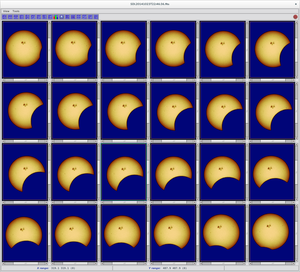
24 images of the partial solar eclipse, 23rd Oct., 2014
Credit: AIP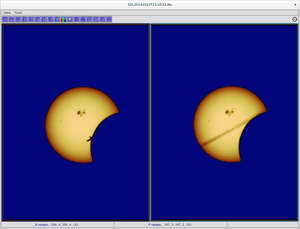
An airplane passing per chance in front of the solar disk.
Credit: AIPInvolved AIP sections and groups:
Telescope Control and Robotics, Technical Section, High-resolution Spectroscopy and Polarimetry, Solar Physics